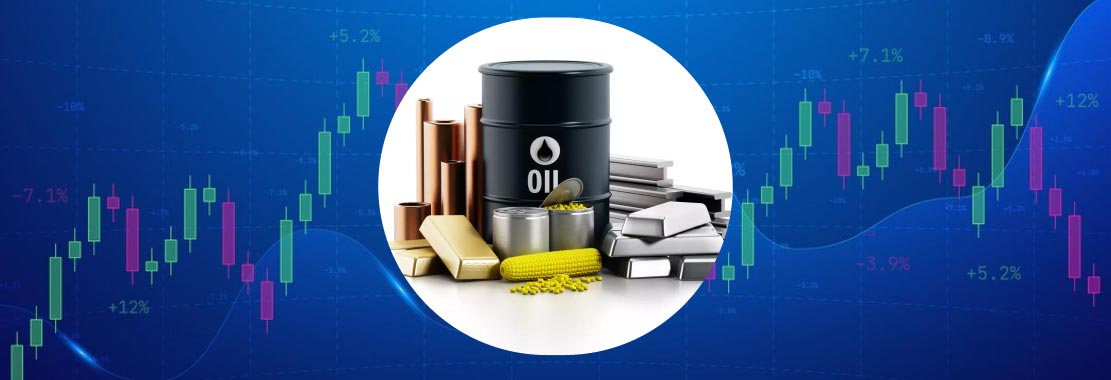There are many different types of trading like trading stocks or bonds. Similarly, commodity trading is one of the many kinds of trading. Commodity trading is based on trading physical assets, unlike stocks or bonds. Commodities like crude oil and agricultural produce are traded in this manner.
Here’s a look at everything you need to know about the question “What is commodity trading?”.
What is Commodity Trading in India?
The term commodity trading is exactly as it sounds. Commodity trading involves the buying and selling of physical commodities on the exchanges dedicated to trading in them. Commodities are physical assets like agricultural products, raw materials, precious metals, energy resources etc. With the help of these dedicated exchanges, investors gain access to specific platforms that help them trade based on standardised commodity contracts. India has more than 20 commodity trading exchanges that are overseen by SEBI, making it easier and safer for traders. Up until 2015, the commodity market was overseen by the Forward Markets Commission. This eventually merged with SEBI making the process of regulating the market a more comprehensive process.
The History of Commodity Trading in India
Commodity trading in India began in 1875 with the setting up of the Bombay Cotton Trade Association. This was the first commodity trading centre in the country. After this, in 1893, the Bombay Cotton Exchange Ltd was set up, which further laid the foundation of futures markets in edible oilseeds complex, raw jute and jute products and bullion. It was in 1900 that the Gujarati Vyapari Mandli was set up, to conduct futures trading in groundnut, castor seed and cotton. From here, futures trading for raw jute and jute products, gold and silver, oil seed complex, foodgrains, spices, vegetable oils, sugar and cloth began. However, it was only in the 1960s, after India’s independence, that commodity trading picked up. Futures trading, however, only existed in pepper and turmeric. It was in 1992 that futures trading in hessian was allowed and then in April 1999 future trading in edible oilseed complexes was allowed. Then April 2003 saw future trading being allowed for all commodities by the Indian government.
Major Commodity Trading Exchanges in India
To be specific, there are 6 main commodity trading exchanges in India. These are listed below:
Example of Commodity Trading
How Does Commodity Trading Work?
Here’s an example of how commodity trading in India works:
Say for example that you decide to invest in a gold futures contract on MCX.
The price of the contract comes to ₹80,000 per 100 grams of gold.
The exchange has a margin requirement of 3.5% which means that you would need to pay ₹2,800 lumpsum amount to buy the contract.
If, after buying the contract, the price of the gold rises to ₹81,000 per 100 grams the next day, an obvious profit of ₹1,000 has been gained.
This profit is credited to your bank account.
However, if the price drops to ₹79,500 the next day, you will incur a loss of ₹500, which gets debited from your bank account.
With commodity trading investors can control a greater position with a small initial investment.
Investors, however, need to know that, because of the volatility of the price of commodities, investing in commodities could prove to be risky.
Types of Commodity Trading Markets
There are two main types of commodity trading markets. Both are listed below with the necessary details:
Spot markets:
Also known as cash or physical markets, spot markets are commodity trading markets where traders and investors can exchange physical commodities that can be delivered immediately.
Derivatives markets:
There are two main types of commodity derivatives in the country; futures and forwards. The former is a standardised agreement that is traded on exchanges and the latter is a personalised deal that is traded directly between parties.
Advantages of Commodity Trading
Commodity trading has quite a few advantages. These are listed below:
In the commodity market, traders can increase their profit potential as they can take a higher market position by only paying a 5% to 10% margin.
With this method, even a slight price increase helps add to an investor’s profits.
However, investors need to remember the minimum margin requirement varies from one commodity to another.
There are affordable minimum deposit accounts and controlled full-size contracts.
Investing in commodities can prove to be a great way to diversify one’s portfolio since most raw materials in the commodity market are negatively correlated to stocks.
The best part about the commodity market is that it is very well regulated.
With the help of the electronic trading suite, the process of trading has become more transparent and efficient.
Disadvantages of Commodity Trading
Like any method of trading, commodity trading has certain advantages, but there are a few disadvantages as well. Here is a list of some of them:
If you are inexperienced in margin trading, this aspect could end up proving counter-productive for you
Any slight fall in price can make investors lose a significant amount.
The reason why traders gain higher returns in commodity trading is because of the high volatility in the price of commodities
However, it is not necessary that this volatility prove to be only beneficial since if it goes against the traders, they could incur significant losses.
To generate high returns via commodity trading, traders need to invest in bulk.
Since most commodities have a cyclical profit window, the value of the investment made by a buy-and-hold investor gets eroded over time.
Conclusion
Commodity trading, while adding to the global economy, can also be very beneficial for investors. However, it is important to consider all aspects of commodity trading when you are trying to enter the market.
Disclaimer: Investments in the securities market are subject to market risk, read all related documents carefully before investing.
This content is for educational purposes only. Securities quoted are exemplary and not recommendatory.
For All Disclaimers Click Here: https://bit.ly/3Tcsfuc















